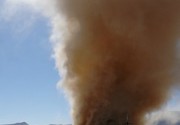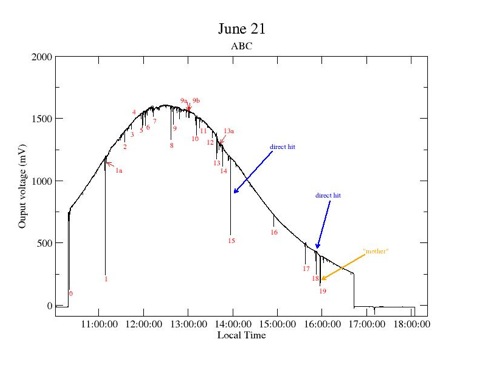|
The REMS ultra-violet sensor (REMS-UV) was tested under field operation conditions in the Eldorado Valley, near Boulder City, Nevada, during a field campaign that took place between June 19 and June 26 2009. The test site is a dry playa lake with little to no vegetation surrounded by low hills and alluvial fans. At that location, Dust Devils form frequently, particularly during the summer months. Dust Devils are ubiquitous phenomena on Mars and their detection and study is one of the goals of the REMS mission. Although Dust Devils tend to come in sequences the time and place of the formation of a particular Dust Devil is unpredictable. Therefore, on Mars, the chances of caching a Dust Devil in camera are slim and although this has been achieved a few times in the past it was always a serendipitous realization. Dust devil hiting the sensors. The aim of Eldorado 2009 field tests was twofold:
The field tests were performed in coordination with research groups of the Planetary Science Institute (PSI), Arizona, the University of Michigan (UM) and The Open University, UK (OU). In addition to meteorological measurements these groups performed a visual survey within a triangular area of ~500 m side length defined by meteorology masts raised at the vertices. The PSI and OU groups also operated mobile platforms (i.e trucks) on top of which different instruments suites were mounted. These trucks were used to track fully developed Dust Devils, follow their path, and get ahead of them to promote encounters. These encounters were considered fully successful when a penetration of the core was achieved, i.e. when the axis of rotation of a Dust Devil passed directly over the sensors. An Engineering Model of the REMS-UV , almost identical to the instrument that will operate on Mars, was mounted inside a protective box that had a rectangular opening to allow the photodiodes to receive solar radiation. Part of the tests were performed using a stationary set-up whereby the sensor was placed at close range of both a commercial weather station and a second meteorological mast. The latter featured 3D sonic anemometer, a so-called Prandtl tube, an instrument to measure with great precision the drop in pressure at the passage of a Dust Devil core, as well as a device to measure electric fields in the vicinity of Dust Devils. For two full survey periods, extending from approximately 11 am to 5 pm local time, the UV sensor was mounted on top of one of the trucks, once adjacent to an anemometer and wind vane and in the other occasion next to a UV spectrometer. This graphs shows the output of the ABC channel – the one with the highest output and lowest S/N ratio. The data was collected on June 21 in a fixed set-up. This was a day of almost permanent clear sky and therefore there is little evidence of variations on a scale compatible with the passage of clouds in front of the solar disk. In addition to fast, small amplitude fluctuations, at least 19 deep troughs (or inverted peaks) can be identified as corresponding to short duration obscuration events |
Dust devil on Earth The wind sensor measures the local wind speed and direction in three cylinder spots. By a combination of data recorded by the three sensors, the wind direction and Speedy upstream is computed. At each spot, there is an anemometer based on heat film technology. Wind Speedy is proportional to the power injected to maintain constant the Films temperature. Soil Temperature The only way to a contactless measurement of a body temperature is throughout its infrared radiation emission. REMS sensor uses that concept, records ground infrared radiation and based on it make an estimation of ground temperature. |
Home / News / An ultraviolet sensor model has been tested at the Nevada desert to explore its capabilities to detect dust devils

